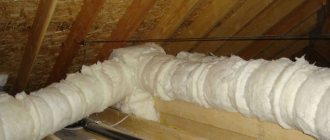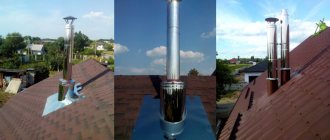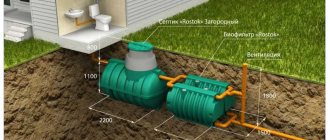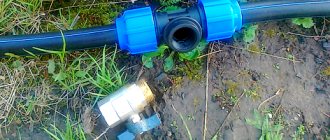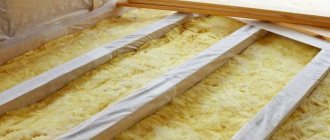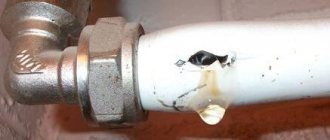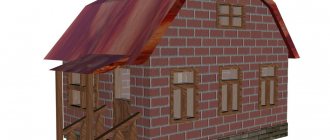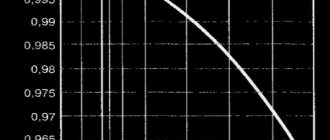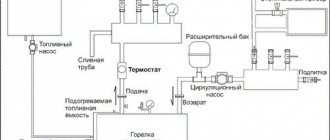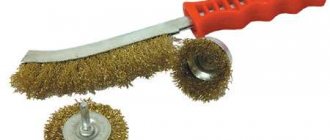What causes condensation to appear?
Such ventilation will definitely produce not just condensation, but water will pour in.
Condensation is the formation of moisture on the inside of the pipe. Drops of water seep through numerous joints, as a result the walls and ceilings will be constantly wet. In winter, the gap in the pipe may disappear due to water freezing, so there will be no air circulation in the ventilation duct. The reasons why ventilation leaks in a private house are as follows:
- lack of thermal insulation on ventilation pipes;
- improper insulation of pipes was performed;
- During the installation of ventilation, defective materials were purchased;
- poor insulation of floors and walls, ice;
- the house was built on a wet foundation;
- water in the basement of the house;
- ventilation pipes become clogged with debris over time;
- faulty water supply in the house;
- temperature difference outside and inside the house;
- incorrect installation of the hood.
The reasons may also be constant sources of fumes - drying wet clothes in the house, features of the area where the house was built, for example, near a lake or river. In any case, if it drips from the ventilation, then it is necessary to take action.
Condensation in pipes
The physics of this process consists in the precipitation of moisture, which is in a dissolved state in the air, on surfaces that have a lower temperature. It is necessary to get rid of such a harmful factor immediately after its appearance, since water leaks can damage finishing materials, cause the development of fungus, destroy building structures or cause corrosion of metals. Prolonged exposure to mold spores that are aggressive to the body can lead to the development of respiratory diseases, pneumonia, and allergic reactions.
The causes of condensation are:
- Absence or insufficient thermal insulation of ventilation ducts in the room;
- Significant temperature difference in the room and in the places where the ducts are laid. This can be observed especially often in winter, in attics.
- Operational disturbances in the operation of the ventilation system. Blockages, deformation, and failure of equipment can cause a decrease in air exchange flow.
- Miscalculations at the design stage of the ventilation system, improperly installed ventilation or low quality equipment that is not capable of delivering the required performance.
- Problems with the building itself - close groundwater, flooded basements, constantly wet foundation, poor quality of insulation of the entire house.
How and where to properly insulate ventilation ducts
Insulation of pipes is necessary in places where temperature changes occur. In a private house, this should be done starting from the ceiling of the top floor through the ceiling and attic, ending with access to the roof. The temperature of the ventilation duct wall changes and condensation forms. This zone is called the “dew point”, so it should be insulated.
Important! Supply ventilation requires a special approach. To prevent condensation, it may be necessary to insulate not only pipes, but also valves (in large rooms). It all depends on the length of the ventilation duct and the specifics of its installation.
The insulation layer must be at least 100 mm.
In any case, insulation should begin by finding the “dew point”, then an economic calculation is made, and the type of insulation is selected. In the latter case, you can choose the following materials:
- polystyrene foam;
- mineral wool;
- polypropylene foam;
- foamed polyethylene.
Materials that help avoid condensation in ventilation are, in principle, inexpensive, have good thermal insulation, and also meet fire safety requirements. When choosing thermal insulation, you should proceed from the length and diameter of the ventilation ducts.
What other ways are there to get rid of condensation?
First, you should find sources of high humidity in the room. Ventilation ducts in the kitchen and bathroom are checked by attaching a sheet of paper to the outlets. If the draft holds the sheet, then there are most likely no problems with the operation of the ventilation system. If the sheet is held weakly or does not hold at all, it is necessary to clean the channels from dirt, dust and grease that remains on the walls of the ventilation duct.
Even if there is no supply ventilation, it is necessary to ensure the penetration of fresh air into the room. In order not to increase the level of humidity, it is recommended to wipe the surface dry after wet cleaning. Today, there are special fans that are equipped with humidity sensors. Such devices allow you to stabilize the indoor microclimate by removing air and unpleasant odors outside the room.
Fans with humidity sensors
Materials such as mineral wool and glass wool are used to insulate pipes. Also, auxiliary components in the insulation composition can be: rubber, polystyrene and foil-type insulation. Directly during insulation work, it is necessary to monitor not only the tightness of components and all connections, but also thoroughly wipe the pipes. This is done so that condensation does not occur under the insulation layer. There is a way to combat condensation, which involves using special heaters for ventilation systems that heat the supply air and are quite effective, but they require a lot of electrical energy and are not economically viable.
To fix the insulation, use a screed or special construction tape. Also, glue with water-repellent properties is often used for these purposes. At the first signs of condensation accumulation, you should not delay solving the problem, but seek the services of professional companies that have solid experience and track record.
It is necessary to ensure that the difference in the temperature of the flow (stream) and the ventilated room is as small as possible, then condensation will not accumulate in significant quantities. It is also necessary to check the ventilation system for general serviceability. Too weak or insufficient exhaust, lack of air flow and other problems can lead to condensation on the walls of the ventilation system. Mechanical damage or distortion of ventilation system elements can lead to failures and excessive condensation formation.
Pipe insulation: priority of work
- The ventilation pipe is wiped dry.
- The selected insulation is tightly wound around the problem area of the pipe and fixed.
- Insulation materials, which are shaped like a pipe, are cut along the entire length on one side.
- Then you should put it on so that all areas fit tightly, it is necessary to achieve complete tightness.
- Only then is the cut seam sealed with glue or tape.
Important! If the insulation does not fit tightly, the condensation in the ventilation pipe will wet the thermal insulation. This will lead not only to the formation of mold and a damp smell, but also to rust - soon the pipe will have to be replaced.
Expert advice
Based on the above information, you can give some practical advice that will help avoid the appearance of condensation in the ventilation system.
- Carry out thermal insulation measures along the entire length of air ducts that pass through unheated rooms and the street. Be sure to insulate all additional devices present in the system.
- If the ventilation outlet pipe runs over a large area on the street, then a tee with a condensate drain must be installed on it. But keep in mind that at low temperatures, condensation inside the device may freeze.
- Mandatory installation of a visor or deflector on the upper end of the ventilation pipe.
- Install a flow-through hood in the kitchen with an outlet to the street or a fan through the window. This is the room with the highest humidity when food is being prepared.
Examples of insulation errors
Winter ventilation duct configuration
Example #1
The bathroom has no windows, its size is 2 x 2.5 m. Ventilation is made in the form of a PVC exhaust pipe with a cross-section of 110 mm. Through the wooden ceiling, the ventilation duct goes into the attic (2.5 m long) and then onto the street. Moreover, the section of the ventilation pipe in the attic is insulated. Vent pipe in the bathroom with a built-in fan with a check valve. In winter, condensation begins to drip in the ventilation system. How to solve a problem?
It all comes down to improper insulation. It was necessary to correctly calculate the “dew point”. Even if the pipe in the attic is insulated, it remains open in the ceiling, a temperature difference occurs and, as a result, condensation forms. Therefore, it is recommended to insulate it, starting from the ceiling and ending with the exit to the street, using heat-insulating materials. Some owners also insulate the street part of the air ducts, which is also correct.
Example #2
In old buildings, the ventilation system is presented in the form of an asbestos pipe passing through the attic to the street. In sub-zero temperatures, you may find that the vents are dripping, and in some cases water is coming out in buckets. Many owners wonder if insulation will help? After all, cold air cools down and turns into condensation.
In private houses, starting from the ceiling, you should wrap the pipe with insulation so that the thickness is 100 mm; a deflector should be installed at the end of the ventilation pipe. If the house is multi-story, then asbestos-cement pipes, like galvanized ones, have a space between them that is not sealed. Therefore, cold air cools this area, forming condensation in the supply ventilation.
To eliminate the problem, it is necessary to make spacers, install formwork and fill it with cement. This method of combating condensation prevents cold wind masses from entering the ventilation. The air ducts in such houses are located in a brick pipe; it is necessary to examine it. If necessary, use mortar to seal the cracks between the bricks. Next, use insulation to wrap the air duct. Such simple methods help eliminate condensation in ventilation.
An ancient but effective way
It is better to prevent a problem than to solve it later.
Condensation is an unpleasant thing. Vapors settle on the walls of the ventilation pipe, and the wind blows raindrops inside. Even the cap is not a hindrance to him. The temperature difference between inside and outside leads to the formation of moisture. What to do? Please note that water droplets collect at the end of the ventilation duct. There the steam cools, condenses and begins to flow down
To avoid this problem, it is enough to perform some steps during installation:
- The part of the pipe that goes out onto the street is joined to each other, against the “wool”.
- Place a tee at the bottom with a conical plug with a hole made.
Moisture will flow out through this hole.
Other methods for eliminating condensation
Proper organization of condensate drainage
Option 1
Perhaps the option with insulation is not suitable for someone, so you can do it differently. The vent pipe that runs through the attic becomes disconnected. A tee with a conical plug is inserted at the disconnection point. It is into the place of the cone that the condensate will flow. The disconnected part of the ventilation pipe that goes outside should be installed in a tee. This method is called condensate removal from exhaust ventilation ducts. It is not expensive and does not require much effort, the main thing is to install the tee correctly in the air duct. Next, you need to insulate this structure, and instead of draining the condensate, you can install a tube through which the condensate will flow.
Important! At sub-zero temperatures, the condensate in the tube may freeze, so this method can be considered temporary and does not solve the problem.
Example
The private house has 2 bathrooms, each of them equipped with exhaust fans in the ventilation ducts. For ventilation, metal pipes with a cross-section of 125 mm were chosen. Ventilation pipes in a horizontal position pass through an unheated attic (the length of one pipe is 7.5 meters, the length of the other pipe is 9 m), then they go outside. The pipes are insulated with mineral wool. In winter there is condensation, what should I do? Moreover, its quantity is very large, water flows out even through the fans.
There are several options for solving the problem; the pipe must be insulated completely, right down to the last section facing the street. You can mount the ventilation pipe outlet directly on the roof without horizontal sections, equipping it not with a duct fan, but with a turbo deflector. The last best option is to install a drain in a place where the ventilation in a private house drips condensate, through which the water will quietly drip, for example, into a sewer drain.
Moisture can be removed from the ventilation through a tube, directed in the desired direction
Option #2
A plug is made on the old ventilation and a new forced ventilation system is installed. An exhaust fan is installed in the room where the most evaporation occurs. Often the mechanical device is mounted in a window vent. The supply of fresh air can be provided by a supply valve, which is installed near the battery or behind the gas boiler. Installing supply valves near heating equipment will heat the winter air and heat loss in the house will be minimal. This expensive option allows you to permanently remove condensation from the ventilation.
The correct approach to insulating ventilation pipes solves the following problems - increasing the operation of ventilation ducts. Noise insulation during the passage of air masses. Reducing heat loss in winter. Condensation does not drip from the ventilation in a private house. Prevents the spread of fire in case of fire.
Today, insulation materials in stores are presented in the form of cylinders, cords, and half-cylinders. The diameter must also be selected individually. The thickness of the insulation is also different. It is advisable to approach the issue of insulation of ventilation ducts at the stage of building a house.
Where and how to insulate correctly
Moving on to the question of how to properly insulate ventilation, you need to understand that much will depend on the insulation used and its thickness.
Traditionally, ventilation insulation was carried out with glass wool or mineral wool. Today, the range has expanded due to the appearance on the market of so-called shells. These are cylindrical pipes consisting of two or more segments. They are simply placed on the air ducts and secured with tape or wire. Shells are made from the same mineral wool, polystyrene foam, polyurethane foam and other foamed polymers. It is necessary to combat condensation in ventilation from the position of accurately identifying areas. If we talk about a private house, then this is an unheated attic. At the same time, the shortcomings can be eliminated very simply - completely thermally insulate air ducts, valves and other equipment, if provided for by the system design. If the ventilation wiring is located under the ceiling, and it, in turn, is insulated along the attic floor, then thermal insulation of this area is not necessary.
There is a way to remove condensate from ventilation when non-insulated areas are equipped with special devices called condensate drains. That is, the condensate formed in the system is collected in this device and removed outside. This option is effective in terms of protecting interior spaces from damp smudges on the walls and drops from ventilation grilles.
Condensation in ventilation: why it forms and ways to solve the problem
The presence of condensation is indicated by areas of rust on metal parts
Typically, filter ventilation is a complex technical device with many branches. It is not always possible to disassemble it and see where the drops form for a number of reasons. In this case, you have to approach the problem indirectly - look for signs of a defect on the outside.
The first sign of water formation on the walls of a metal channel may be areas of rust. If the shaft is covered with insulation, wet areas will still appear, making the insulation material itself wet. In this case, the damaged material is removed and a new one is put in its place.
Another potential problem area may be a section of ductwork that extends above the roof covering. In order to save money, they do not always organize insulation in this place, which often leads to icing of the material.
Content
